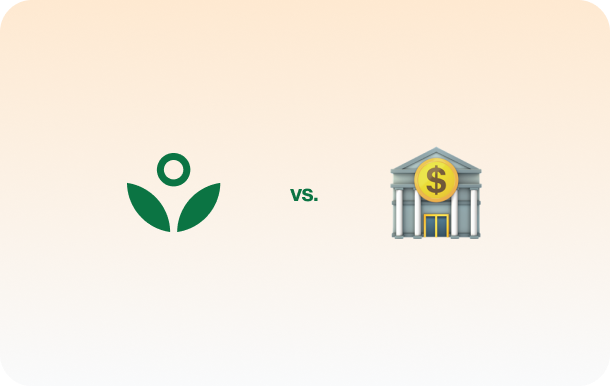
The Ultimate Guide to Paying off Credit Card Debt
Paying Off High-Interest Credit Card Debt Should Be a Top Priority

Paying Off High-Interest Credit Card Debt Should Be a Top Priority
written by
Credit card debt can feel heavy, and if you’re carrying some, you’re not alone. With high interest rates, it’s easy for balances to grow and hard to stay on track with your financial goals. On top of that, debt often brings stress and shame, making it even tougher to manage. But there’s a way forward. In this post, we’ll walk you through a step-by-step plan to pay off your credit card debt, so you can lighten the load and focus on what really matters to you.
Why Paying Off Credit Card Debt Should Be a Top Priority
Credit card debt is some of the most expensive debt out there, with interest rates often hitting 20% or more. Every month you carry a balance, a chunk of your money goes to the credit card company—money that could be building your wealth instead.
The good news? If you think of paying off debt as an investment, every dollar you use to pay down a credit card with 20% interest is like getting an instant 20% return. That’s way better than the 5% you might earn in a high-yield savings account and even higher than the long-term return from most diversified investment portfolios.
There’s also the emotional lift that comes with paying off debt. Almost everyone we’ve worked with has described feeling a huge sense of relief after clearing their balances. That sense of freedom alone makes it a goal worth pursuing.
So, how do you do it? How can you pay off your credit card debt for good? Let’s walk through it step-by-step.
Step 1: Know Where You Stand
The first step is getting a clear picture of your current debt situation. You can’t make a plan without knowing exactly what you’re working with.
Here’s what you need to figure out for each credit card you have:
- Current balance: How much do you owe?
- Interest rate: What is the interest rate being charged?
- Minimum payment: What is the minimum amount you’re required to pay each month?
Write everything down in one place, whether it’s a spreadsheet or just a list. Seeing it laid out helps you face it head-on and gives you a starting point for creating a plan.
Step 2: Track Where Your Money Is Going
Next, it’s important to take a close look at your budget. The goal here is to both figure out where your money is going now, and what adjustments you could make to help you pay down your credit card debt even faster.
Start by tracking your spending—both fixed expenses (like rent and bills) and discretionary spending (like eating out or subscriptions). This helps you identify what you need and where you might be able to cut back, even if it’s just temporary change.
If possible, try to find at least a little bit of room for extra payments on top of the minimums. Every extra dollar you pay will save you money and accelerate your path to debt-free.
Step 3: Balance Your Other Financial Needs
With that information in hand, it may be tempting to throw every spare dollar at your credit card debt. But before you dive in, take some time to check on your other financial goals to see if anything else might need to be prioritized first.
Here are some things to consider:
- Do you have an emergency fund? A small emergency fund of $1,000–$2,000 can protect you from having to rely on credit cards for unexpected expenses.
- Are you maxing out your employer’s 401(k) match? If your employer offers a 401(k) match, it’s essentially free money that is often an even better return than paying down credit card debt.
- Are there other near-term needs? If there’s a big expense coming up in the near future, you might consider setting money aside so that you’re ready for it.
These steps should often come first before going all-in on debt repayment. They create security and help build a foundation for future financial success.
Step 4: Pick Your Debt Payoff Strategy
Now that you know your numbers and have a budget, it’s time to choose your repayment strategy. There are two popular methods.
With the debt snowball strategy, you prioritize paying down the card with the lowest balance first. Once that card is paid off, you prioritize the next lowest balance, and so on. This strategy can be motivating since it gives you quicker wins.
With the debt avalanche strategy, you prioritize paying down the card with the highest interest rate first. Once that card is paid off, you prioritize the next highest interest rate, and so on. This is the most efficient strategy since it prioritizes the cards that are costing you the most.
Both strategies are great, so I would focus on choosing the method that you feel like will be easiest to stick with. The best plan is the one you consistently execute.
Step 5: Automate Your Payments
Consistency is key, and automating your payments helps you stick to the plan without thinking about it.
Once you’ve chosen your strategy, set up automatic payments for the minimum on all cards. If you have extra money each month to put towards your credit card debt, add that amount to the automatic payment for whichever card you’re attacking first. And once one card is paid off, add that payment to the automatic payment of the next card.
By automating everything, you reduce the room for human error and make it more likely you’ll stay on track, even during busy times.
Step 6: Stay Disciplined and Review Regularly
Paying off credit card debt takes time, so it’s important to stay disciplined. Regularly check in on your progress, whether that’s monthly or quarterly, and adjust your plan as needed.
Has your income changed? Have you cut back on spending in certain areas? Are there any new expenses to take care of? Can you increase the amount you’re putting toward repayment? The more you can throw at your debt, the faster it will disappear.
Remember, this is a marathon, not a sprint. It’s okay if progress feels slow at first. As long as you’re moving forward, you’re making progress.
Step 7: Use Extra Money to Supercharge Your Debt Repayment
Whenever extra money comes your way – whether it’s side income, a bonus, or RSU proceeds, put it towards whichever credit card you’re currently prioritizing.
I’ve seen windfalls like that save members thousands of dollars in interest and knock months, or even years, off their repayment timeline.
Step 8: Celebrate Your Wins
This can be a long process and it can be hard to stay motivated. Which is why it’s important to celebrate your wins along the way!
Whether it’s paying off a card, getting below a certain balance, or simply increasing your monthly payment, those are all big moments. Find ways to recognize your progress and celebrate those wins (without racking up more credit card debt)!
Taking time to reflect and feel good about the progress you’re making is really important. You deserve it.
One Step at a Time
Credit card debt can feel like an impossible burden. I’ve talked to plenty of people who feel like they’ll never get out from under it.
But you can do it. If you follow the plan above, you will be debt-free eventually. It may take time, but every payment you make is one more step towards financial freedom. Stick with it, make adjustments as needed, celebrate along the way, and you will get there.
And if you need a hand, Fruitful’s financial guides can help you make a plan that fits your specific goals and situation. Don’t hesitate to reach out!
Additional articles
© Fruitful 2025 — All rights reserved. “Fruitful” refers to Fruitful, Inc. and its wholly-owned, affiliated, and separately managed subsidiaries, Fruitful Financial, LLC and Fruitful Advisory, LLC, an SEC-registered investment adviser. To learn more about Fruitful Advisory, LLC please view its Form ADV Part 2 and Form CRS available at www.adviserinfo.sec.gov. Registration with the SEC does not imply any level of skill or training.
This information is provided by Fruitful for educational and illustrative purposes only and is not considered an offer, solicitation of an offer, advice, or recommendation to buy, sell, or hold any security. All investing involves risk, including the risk of losing the money you invest, and past performance does not guarantee future performance. Rebalancing cannot assure a profit or protect against loss in a declining market. Fruitful relies on information from various sources believed to be reliable, including information from its Members, Clients, and other third parties, but cannot guarantee the accuracy or completeness of that information.
Fruitful is a financial technology company, not a bank. Deposit accounts provided by Emigrant Bank, Member FDIC. Funds in the bank accounts are insured for up to $250,000 per depositor, depending on the ownership category. Interest rates are variable and subject to change at any time. These rates are current as of July 18, 2024.
¹ The people in these videos are real Fruitful Members who were paid in cash for their time and participation in this series. We think that is fair. Each testimonial reflects the individual Member's experience as an advisory Client and is not intended to represent any other Member's or Client's experience. We believe in the integrity of this approach and that, outside the conflict of interest present due to compensation, no other conflicts apply to these testimonials. These Client testimonials were given in October 2023, represent the opinions of each Member at that time, and may have been edited for brevity and clarity.
² Cost of traditional advisory firms sourced from The Kitces Report, Volume 2, 2022, Figure 61. Distribution Of Typical Annual Retainer Fee.


